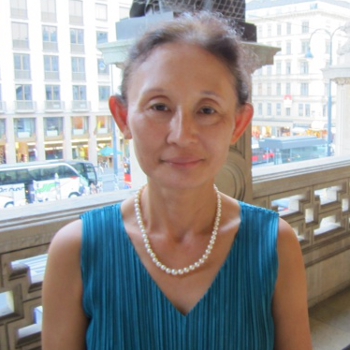Attending an opera or concert featuring Slovak soprano Edita Gruberova is always an event. She is unique not only in the longevity of her career, but also in her continued specialization in bel canto repertoire that demands both agility and beauty in executing coloratura passages, not to mention technical assurance to sustain legato lines and hit high notes without strain. The audience expects only the best from her, and the pressure to perform must be enormous.
The minimalistic production was first mounted in 2009 for Gruberova. The director Christof Loy, in his characteristic fashion, uses a tall light grey wall as backdrop with dark grey floors. Shortly before the music begins, we see young men dressed in black suit, tie and white shirt stroll onto the stage. Huge letters in white, LUCREZIA BORGIA, are mounted on the back wall, and as the opera begins and the men sing about the poisonous noblewoman. These letters are brightly illuminated in Don Alfonso’s court in Act I, and the letter B is knocked off by Gennaro, representing his defacing of Lucrezia’s coat of arms.
The only props used are chairs and a desk in Act I, representing Lucrezia’s husband Don Alfonso’s court. The chairs become numerous as Act II begins, with many men in traditional costume representing spies and thieves milling about the stage, some carrying weapons. The crowded stage captures a sinister atmosphere of the act, as the music increasingly depicts violence and death. When Lucrezia’s son (unbeknownst to him) Gennaro’s friends are poisoned at the end of the opera, they go to the back of the stage and sit down with their back towards the audience, signifying their death. Gennaro joins them in death, although they all remain on stage and thus witness Lucrezia’s agony as she watches her son die at her own hands.
The grey wall that covered the entire back of the stage at the beginning shifts slightly to stage right during Act I, and by Act II it covers less than half of the stage, and the letters are almost invisible. The moving of the wall and the disappearance of the letters seem to signify the disintegration of Lucrezia’s carefully manufactured world of power and fidelity. The appearance of her long-lost illegitimate son awakens a warm maternal love in her, but eventually leads to his and thus her destruction.
Verdi is said to have been greatly influenced by Donizetti, and the recent pairing of Lucrezia Borgia and Rigoletto at Caramoor Festival in New York focuses on the similarity of the two works. In Loy’s conception, the attraction between Lucrezia and Gennaro is, from the beginning, clearly of mother/son nature, with no sexual connotation. Rigoletto is a father/daughter love story, so the parallel between the two operas is visible in this production. Verdi drew heavily from Donizetti in his musical writing. It is striking how Gennaro’s best friend Orsini’s drinking song in Act II, sung by a mezzo, has lines that one recognizes in Princess Eboli’s Veil Song in Don Carlos. Numerous examples of musical parallels between Donizetti and Verdi can be drawn, but Donizetti remains firmly in bel canto territory, with arias, duets, trios and choruses that all require beautiful lyric singing supported by solid technique.
The evening’s musical performance was uniformly strong. The conductor began the prelude at deliberate pace, but once the singing began, he propelled the orchestra briskly and propelled the musical drama without much interruption. Other than minor mishaps in trumpets, the orchestra played extremely well, negotiating the rapid passage work skillfully and yet never losing sight of the overall arc of the music's structure. It was unfortunate that the orchestra drowned out the singers in the dramatic trio at the end of Act I, but overall the orchestra provided strong support to singers.
The male chorus was exceptional, their physical actions deftly handled. Pavol Breslik has a beautiful and youthful tenor that cuts through the orchestra, and if his vocal and physical acting was at times a bit monotonous (he sang forte most of the time), his clear phrasing and ability to stand on one leg and hop around while singing difficult passages more than make up for this very small complaint. John Relyea’s rich bass-baritone is capable of dramatic emphasis, and he was a solid match to Gruberova. Silvia Tro Santafe has excellent bright high notes for a mezzo, and her duet with Breslik in Act II was particularly memorable. Minor roles were well sung, with Dean Power's bright voiced Rustighello leaving a strong impression.
Gruberova may not be able to sing all the notes accurately at this point in her career, and her low notes are certainly effortful. However, she has a singular ability to express various emotions of the character by colouring her voice, varying volume, and her singing is totally connected to every word of the text. Her middle to high notes are still piercing and yet elegant. She can hit the big ‘money notes’ loud and clear. Her entrance aria captures your heart with its tenderness and longing, and from then on you are so taken by the beautiful and eloquent voice that you are willing to forgive her for small mishaps and occasionally inaudible notes. You take an emotional journey with her, which ends with a heart breaking and poignant last duet with her son. Her mastery of the craft is truly remarkable.
After a prolonged ovation at the end of the performance, the general manager of the opera house and a minister appeared on stage to honor Gruberova for her 40th anniversary year at Munich Opera. Amid flowers and well wishes, the diva thanked everyone, and said this is not the end: God willing, she will continue to come back to Munich to sing. The applause began again. It was a truly remarkable evening.




